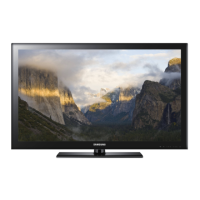
Do you have a question about the Samsung HP-S4253 - 42" Plasma TV and is the answer not in the manual?
| Screen Size | 42 inches |
|---|---|
| Display Type | Plasma |
| Resolution | 1024 x 768 |
| Contrast Ratio | 10000:1 |
| Viewing Angle | 160 degrees |
| Aspect Ratio | 16:9 |
| Input Ports | HDMI, Component, Composite, S-Video, RF |
Provides an overview of the plasma display panel's features and technology.
Details the functions and operations of each button on the remote control.
Offers guidance on safely installing the TV onto a wall mount.
Step-by-step instructions for attaching the TV's stand for tabletop placement.
Guide for connecting terrestrial TV antennas (VHF/UHF) via coaxial cable.
Instructions for connecting to various cable TV systems, with or without a decoder.
How to connect VCRs or other video sources using composite or S-Video inputs.
Steps for connecting and viewing content from a camcorder.
Guide for connecting DVD players using component video and audio cables.
Instructions for connecting digital TV set-top boxes via component or HDMI.
Connecting HD sources via HDMI for optimal digital video and audio quality.
Connecting digital TV set-top boxes using HDMI or DVI connections.
Steps for connecting digital audio systems via optical or coaxial outputs.
Connecting an external analog amplifier to the TV's audio outputs.
How to power the TV on and off using the remote or front panel controls.
Navigating the TV's on-screen display menus and accessing settings.
Automating the channel scanning and storage process for available TV signals.
Programming the TV remote to control other compatible audio/video devices.
Selecting and switching between different input sources connected to the TV.
Adjusting the screen aspect ratio (e.g., 16:9, zoom) for different content.
Fine-tuning picture quality settings like contrast, brightness, and color.
Activating DNIe to enhance image detail, contrast, and color.
Selecting different display sizes such as 16:9, Zoom1, Zoom2, or 4:3.
Enabling and configuring the Picture-in-Picture (PIP) feature for simultaneous viewing.
Choosing the audio source for main or secondary images in PIP mode.
Adjusting sound equalizer settings, balance, and bandwidth for preferred audio output.
Selecting preset sound modes like Normal, Music, Cinema, or Dialogue.
Activating SRS TruSurround XT for an enhanced virtual surround sound experience.
Selecting audio tracks for digital broadcasts, including language options.
Choosing mono, stereo, or SAP audio for analog broadcasts and secondary audio.
Automatically adjusting volume levels based on signal strength for consistent sound.
Setting an audible melody to play when the TV turns on or off.
Disabling the TV's internal speakers and related controls.
Resetting all sound settings to their original factory default values.
Configuring the TV to receive signals from either an antenna or cable input.
Marking and easily accessing preferred TV channels from a custom list.
Browsing through all available channels or a filtered list of favorites.
Adding, deleting, or reordering channels in the TV's memory.
Setting the default channel list display mode (All, Added, or Favorites).
Assigning custom text labels to channels for easier identification.
Manually fine-tuning analog channels for improved picture clarity.
Assessing digital signal strength to optimize antenna positioning.
Activating the Low Noise Amplifier to boost reception in areas with weak signals.
Detailed instructions for connecting a computer to the TV via VGA and audio cables.
Adjusting the PC display position on the screen for proper alignment.
Optimizing PC image quality using automatic or manual adjustments.
Resetting all picture settings to their factory default values.
Setting the TV's internal clock manually or automatically via digital signal.
Scheduling the TV to turn on or off automatically at specific times.
Configuring the sleep timer to turn the TV off after a set period.
Changing the on-screen menu language.
Improving picture quality by reducing noise and interference in weak signals.
Activating a mode optimized for watching movies and improving picture quality.
Displaying a blue screen when no signal is present to prevent image retention.
Optimizing TV settings for video games for reduced input lag and better response.
Enabling and configuring analog closed captioning services.
Enabling and configuring digital closed captioning and text services.
Adjusting the transparency level of the on-screen menu displays.
Activating power-saving features to reduce electricity consumption.
Settings to mitigate screen burn-in by moving pixels or displaying patterns.
Using special screens or patterns to help remove image retention or burn-in.
Enabling or disabling the on-screen help feature for user guidance.
Controlling the blue LED indicator light for power saving and reduced eye strain.
Configuring parental controls using the US V-Chip rating system.
Configuring parental controls using the Canadian V-Chip rating system.
A guide to troubleshooting common issues encountered with the TV.
Recommendations for proper care and maintenance of the television.
Detailed technical specifications, including dimensions, power, and inputs.
Specific physical dimensions and measurements for the HP-R4253 model.
Specific physical dimensions and measurements for the HP-R5053 model.











